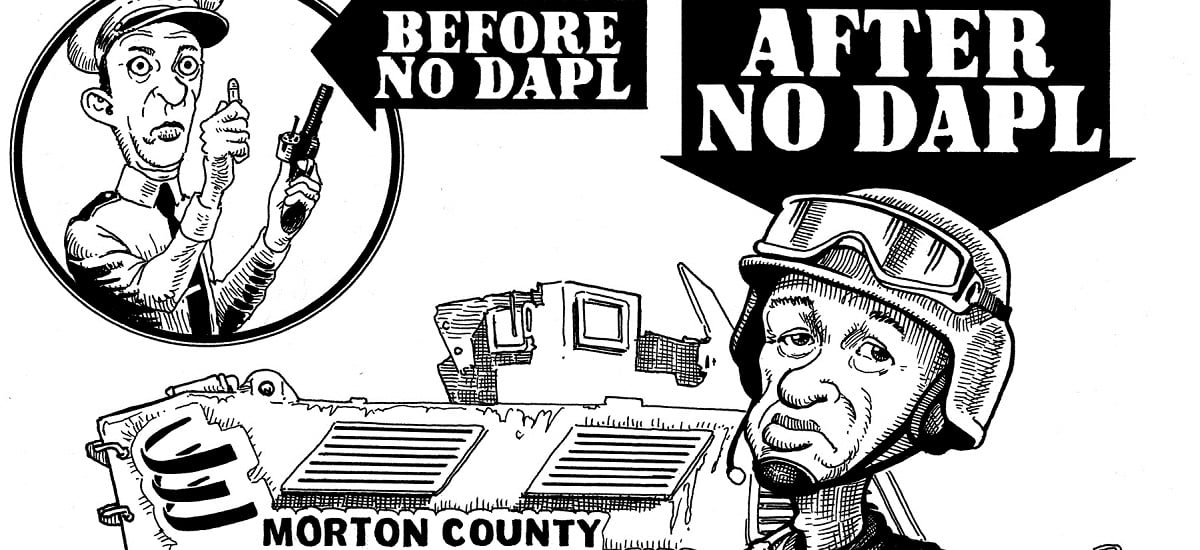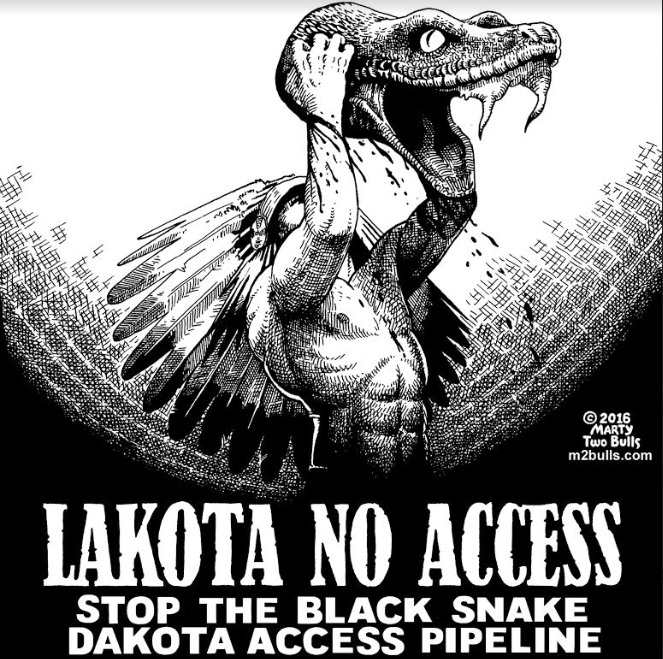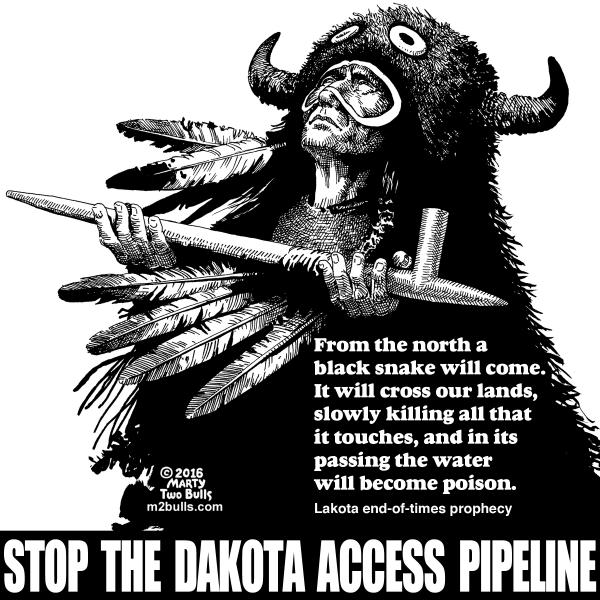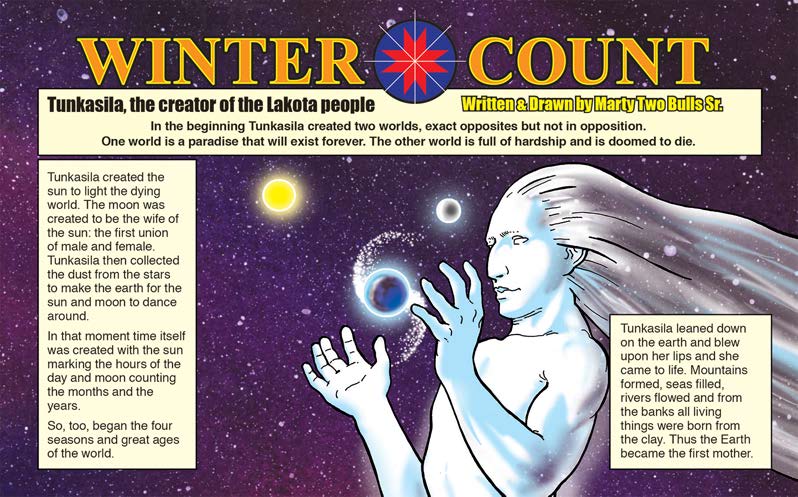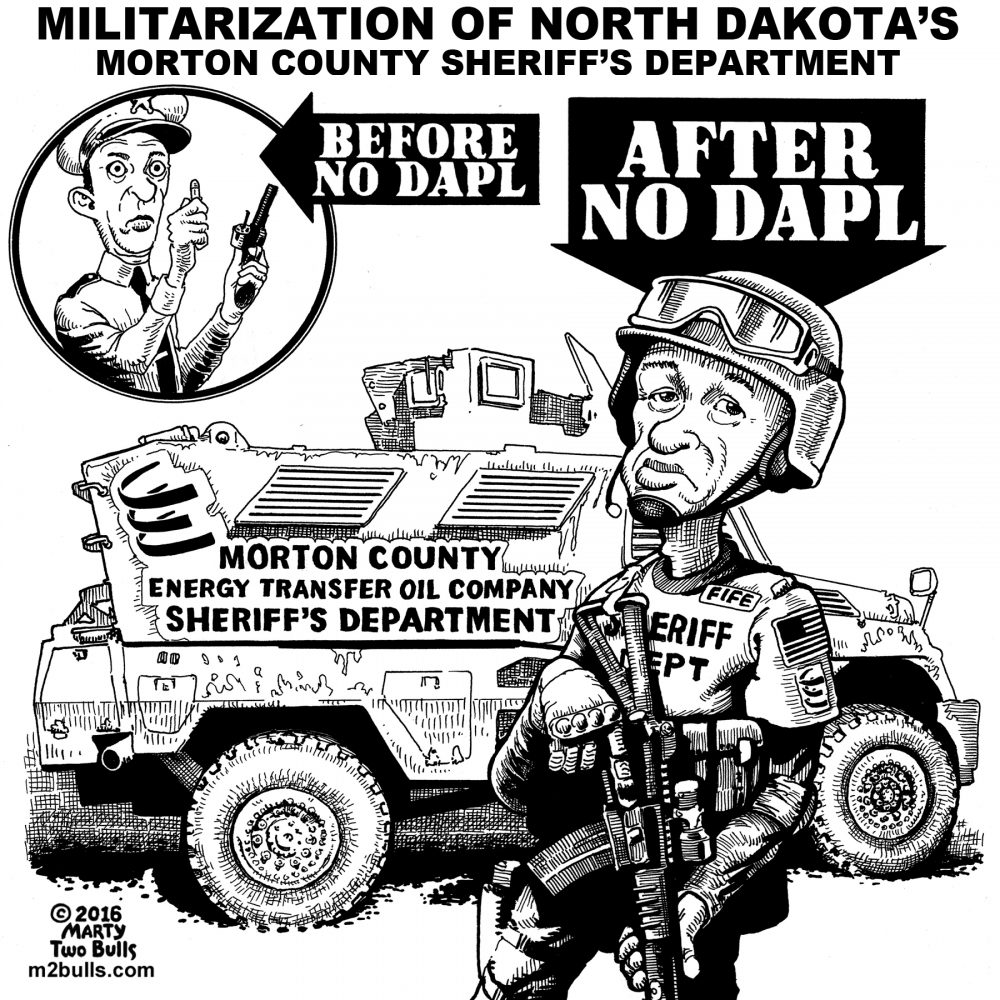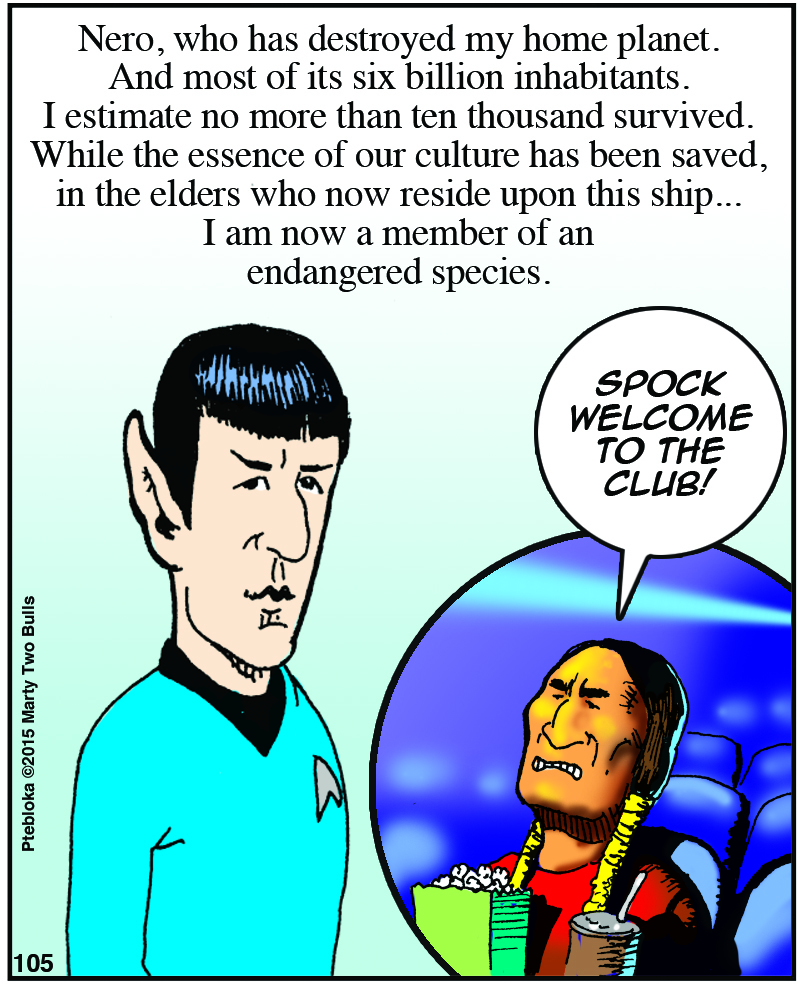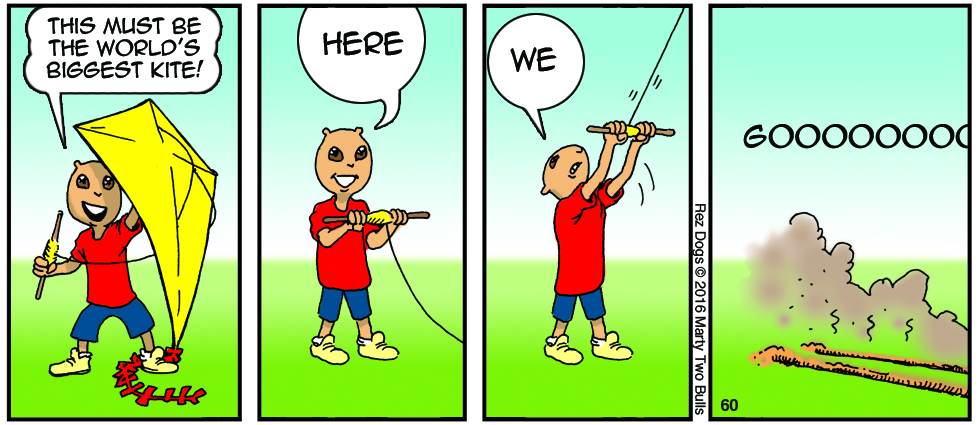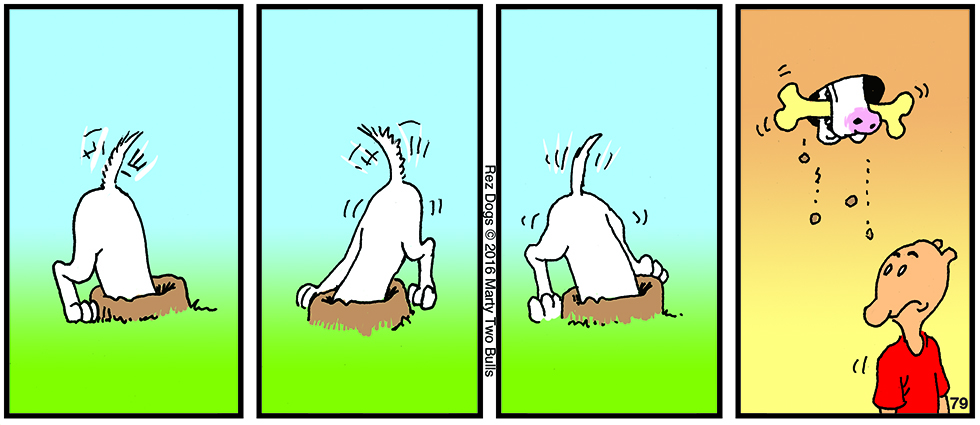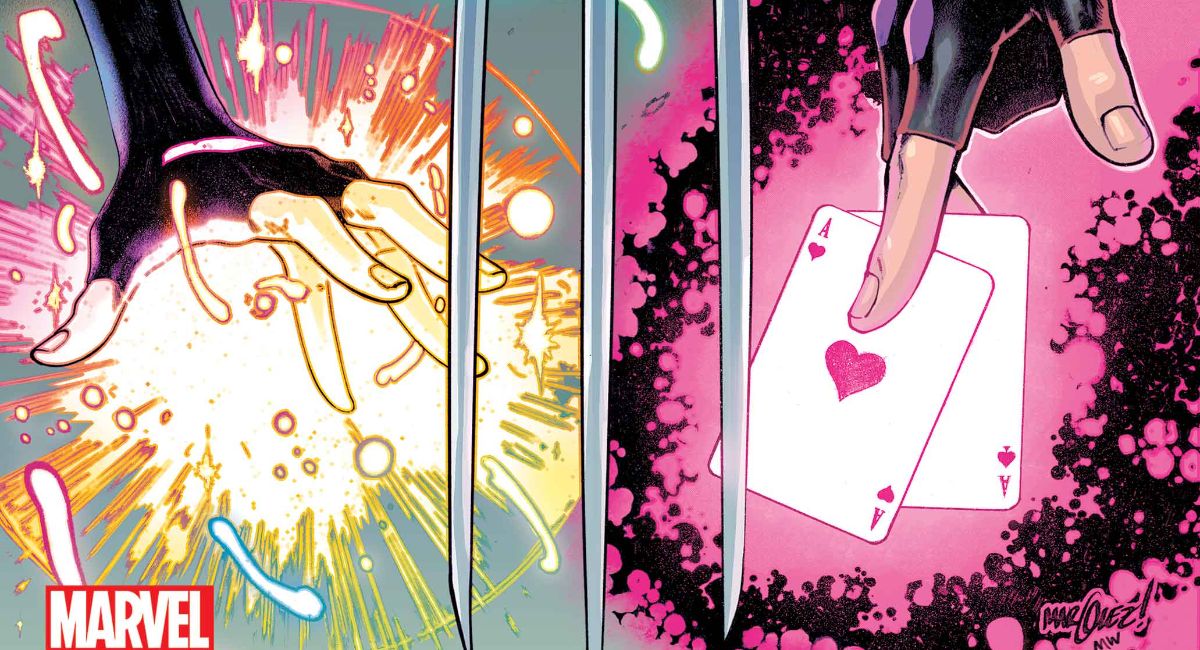by Alex Dueben
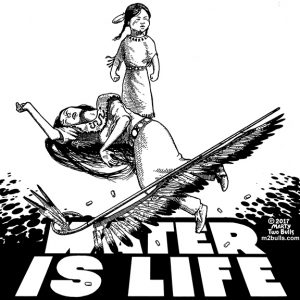
His cartoons are striking, done in pen and ink, a look that owes as much to 19th century cartoonists and lithographers as it does to mid-century artists like John Severin and Wally Wood, who Two Bulls mentioned were his favorite artists when he was young. Many of the images that he’s crafted over the past year around the anti-pipeline movement, and the anti-DAPL fight in particular, have gone viral and were no doubt key to getting this well-deserved attention and acclaim. Two Bulls comes from a family of artists. His uncle was the late western painter Edward Two Bulls and he was kind enough recently to talk about his work, making comics for a Native audience, the other weekly comics that he makes, how his work hasn’t changed but the national conversation has, and his ambition, to spend more time on comics in the coming years.
Alex Dueben: I started following your work last year and I was first alerted to it because of people protesting the Dakota Access Pipeline and a number of comics you made about that fight. I was curious about your background.
Marty Two Bulls Sr.: I’ve been drawing ever since I can remember. My kindergarten teacher predicted I would be an artist. I sold my first painting when I was twelve. I started doing editorial cartoons for the high school newspaper – even though at the time I never thought I’d do it for a living. It was just an English credit. [laughs] After high school I went to Colorado Institute of Art where I studied graphic design and illustration. After that I went to the NBC affiliate in Rapid City South Dakota in ‘83. Then after a couple of years I worked as a designer for a commercial printing companies and then I started working in weekly newspapers. I did a stint as a designer for University of South Dakota then into daily papers.
Dueben: I know that you come from a family of artists. The late painter Edward Two Bulls was your uncle, but you have a number of other relatives who are artists as well.
Two Bulls Sr.: The Two Bulls are a family of artists. I have a lot of cousins and uncles who are artists. When I was growing up my uncles would draw each other, make cartoons of their exploits. They’d put them on the walls of their homes and when we’d go visit the adults would laugh and tease each other about it. I always thought that was neat medium so I started drawing cartoons as a hobby of me and my cousins and what we were doing. That’s where my interest came from, seeing my uncles do it.
I had a choice of being either fine artist or a commercial artist, which is what they called it back then. I had one uncle who was a commercial artist in Denver and Edward Two Bulls was a fine artist and he lived hand to mouth basically, whenever he could sell a painting. My other uncle had a regular paycheck, he had a house, his kids went to good schools. I wanted a family so I chose that route, to be a commercial artist. So I spent a good number of years in commercial printing until I started to get into newspapers. I moved into daily newspapers and I was the graphics editor for thirteen years for two of the largest papers in South Dakota. I did a lot of illustrations and graphs for stories. In those days I was responsible for how the paper looked. I was tasked with integrating the paper with new printing technologies. That was still new. It was ‘85 when the Macintosh computers came along so part of my job was integrating computers and phasing out things like cameras and plates.
Dueben: What kinds of comics did you read as a kid? Who did you like?
Two Bulls Sr.: I really liked John Severin and Wally Wood. As I got older I was into Frank Frazetta and Richard Corben. If you know their art style, you can see where my style comes from.
Dueben: So you were reading a lot of old EC comics, fantasy and horror stuff?
Two Bulls Sr.: As a youngster growing up in the 60’s and 70’s G.I. Combat and Sgt. Rock were big influences as well. I haven’t read a lot of superhero comics, but science fiction and WWII stuff caught my interest. I had uncles that were in World War II and when I was younger, World War II vets were all over the place. You hear their stories and wonder about what it would be like there. Later I discovered underground comics and Heavy Metal. The later introduced me to the work of Jean Giraud (Moebius) which just blew me away. His work on Blueberry was a total about face of his drawing style and that was very inspiring. I always tried to experiment by using different styles to keep my interest.
Dueben: When did you start editorial cartooning?
Two Bulls Sr.: I started at the high school newspaper and then I did some for the weekly paper called Lakota Times in ’88. The editor there would want me to do it a certain way – the way he wanted it – and I did one on spec and after it came out I almost got in a physical fight over it. I said right then and there that from now on I’m going to do what I want to do because my name is on it and if I get in a fight then I won’t feel guilty defending it. It’s my work and not the work of somebody else. So from then on I’ve done what I want. Indian Country Today has been real supportive and let me do what I want.
Dueben: What’s your approach to editorial cartooning? How do you see your job?
Two Bulls Sr.: It’s satire, of course. Looking at politics from a Native point of view, which is lacking in editorial cartoons. I look at issues that affect or concern Native Americans. If non-Natives like my work, all the better because part of it is educating people about the way we feel as Native people.
Dueben: Your audience is a Native audience.
Two Bulls Sr.: That’s who I do it for. That’s my inspiration. You have to figure out who you’re making art for. I made this beautiful painting and some woman in California bought it. My people would have loved to have seen that painting, but they never will. It’s on some person’s wall in California. What I want to do is make artwork for my people to see. Many years ago I was at this Native person’s house and they had an old calendar on the wall that I had done back in ‘85. They cut off the calendar part but they kept the art. It was on the wall in an honored place in their living room. It just struck me that Native people can’t afford my art but they really wanted it or they were touched by it and I started thinking about that. The best way to reach people is through mass media.
Dueben: So making cartoons, working online, that’s a great medium for you.
Two Bulls Sr.: I used to write editorials. I sat on the editorial board of the Rapid City Journal. Nobody knew I wrote them because you don’t sign them, but I came to realize that nobody reads those things. [laughs] But an editorial cartoon, your kids can see it and they understand it. If there’s something funny you can get a laugh out of people that’s powerful because readers will always remember that. Maybe they don’t understand what I’m trying to say. Maybe they see something about a House Bill and they go look it up or maybe it’s a treaty issue. I try to find things that relate to my readership.
Dueben: That’s the tradition of editorial cartoons. That even if people can’t read, they can read the cartoon and understand what’s being discussed.
Two Bulls Sr.: Exactly. I get jealous about how mainstream cartoonists have it easy because they can jump from Clinton to Putin to Trump to a European issue to make their deadline. I have to take the long route by doing a lot of research because Native people are such a minority and people tend to marginalize us. There are not very many stories in the national news cycle about Natives. Leading some people think we don’t exist anymore. Consequently, things that affect us aren’t daily headlines so I have to research to find issues to draw.
Dueben: That’s changed a little this past year.
Two Bulls Sr.: There are a couple issues that came to the forefront. Back in the late sixties and seventies Native issues were on the forefront and then they fell off. It does that, it rises and falls. Right now we’re coming up again with the pipeline issues.
Dueben: I was talking with Lalo Alcaraz recently and he said that he’s been making comics about immigration and anti-Hispanic attitudes and other issues for years and that his work hasn’t changed, but the national conversation has changed. Do you see that as well?
Two Bulls Sr.: Oh definitely. I’ve been doing editorial cartoons every week since 2001 and I’ve just been plugging along doing what I do. Every once in a while you see something come up where people are interested in certain issues and then the news cycle moves on. My readership is basically from Pine Ridge. They’re my people, the Oglala Lakota.
Dueben: You’re Oglala Lakota. What does that mean?
Two Bulls Sr.: Oglala is one of the seven tribes of the Lakota – our enemies call us the Sioux. We’re the branch from Pine Ridge. My ancestor’s chief was Crazy Horse. My family lives around the Red Shirt Table community in Pine Ridge which is a geographically area named for Chief Red Shirt. That is where my family gravitated after the assassination of Crazy Horse. My grandfather was born on December 25th 1900 and he was part of the first generation to be born on the reservation. His father was born a free man and hunted buffalo on the plains and fought Custer. We’re not that far removed from that era. That’s where my tribe is a little different form other tribes. Some other tribes have had European contacts for three or four hundred years so they’ve lost a lot of what they had whereas we still have our traditions, our language, and our religion.
Dueben: How did you end up at Indian Country Today?
Two Bulls Sr.: They used to be called the Lakota Times and the publisher started Indian Country Today and then he sold it, but I stayed on as a freelancer. I kept submitting my work and they kept buying it. They’ve been growing bigger and bigger and I’ve just been there all along. I self-syndicate and appear in four or five other Tribal papers across the country.
Dueben: I was listening to this interview you did the other year on KILI and in this interview you said that journalism at its core is beautiful. Do you think of your comics in those same terms?
Two Bulls Sr.: Absolutely. All my stuff is researched. People come back at me and ask where I got this stuff and I cite facts and research. I just send these guys links and say, read up! [laughs] It’s not fake news. Some of this information about oil consumption and production is from Energy Transfer’s website – and they’re the ones pushing this pipeline! I just try to educate. I never believed in advocacy journalism where people tell you how to think. I always felt that journalism is putting the facts out there and people can decide what they’re going to do with those facts. As I said before; the truth is ugly to some people, they fear it, and even kill to keep it hidden. As a journalist our job is to seek out the truth and display it for all to see. And in that act the truth becomes beautiful.
Dueben: You have a point of view, but you’re using facts to make your point.
Two Bulls Sr.: The way I see my opinion is logical. It’s not something I made up. It’s not fake. [laughs] One thing that is interesting though is the Trump administration is complaining about the media when the reality is that the people are the media. I had a publisher who told me if people just wanted pictures of kitty cats, that’s all we’d have in the newspapers, pictures of kitty cats. But people want to see the car wreck, they want to read about he murders and what the politicians are up to or not up to, they want to know about new taxes and they want to be entertained at the same time. That’s the role of the newspaper. A good publisher understands his readership and will publish the news that he thinks his readership is interested in. The news media is a reflection of the public. When they talk about media, it’s actually just a mirror. It’s the people. That’s what makes the press so powerful and so wonderful.
Dueben: And the best publishers and editors understand what people want, but also what they need and don’t realize they want.
Two Bulls Sr.: Yes, because it’s the truth. The number one job is to uncover the truth.
Dueben: As far as your comics, do you feel the need to be funny? Is humor essential?
Two Bulls Sr.: I like sarcasm, I like to be ironic. A lot of times it’s funny. Sometimes I’ll be serious. There are some [comics] about suicide where I was real serious. At the same time, I like to point out people’s follies. I did this cartoon on White Clay, which is a border town that sells alcohol to the reservation. People are protesting against it. My view has always been, if you quit drinking, it will go away. It’s there because there’s a demand. That might sound like a simplistic and childlike argument. The way I did it in the cartoon was I showed these protestors with signs and then in the back these little kids with signs saying just stop drinking and the protestors are looking back. Readers said, oh that’s so wise coming from little children. I was thinking, no child said that, I said that. [laughs] That demonstrates the power of that medium. How people could take it and put some of themselves in it and give life to the characters. Give life to drawings.
Dueben: And like every editorial cartoonist I’m sure you need a thick skin especially when dealing with these issues.
Two Bulls Sr.: Oh yeah. [laughs] You’ve got to be able to take it. Early on in newspapers I had to keep my phone number and address unlisted to protect my family. There are some people will get bothered by what they read and will threaten you. You learn that it comes with the job. If you’re not making somebody angry, you’re doing your job well. [laughs] I have friends who were journalists in Idaho who had their offices bombed and shot at so I haven’t had it too bad. [laughs]
Dueben: Technically speaking, how do you work?
Two Bulls Sr.: I do pen and ink work. It’s a real conscious effort on my part. There’s a lot of cartoonists today that do a lot of really simplistic drawings, but I go back to the old pen and ink lithograph look. I like those old illustrators like Thomas Nast from the end of the 19th Century. I work in black and white. I use a lot of cross hatching. That’s just my preference. I can do color, I could work faster and I could probably get these done in half the time, but I just like ink. I’ll sit down with a piece of paper, do a drawing in non-repo blue and go over it with ink pen (Koh-n-noor) and then I’ll pick it up with a brush to get contour lines. Then I’ll scan it in and clean it up and edit it in Photoshop. I have a Wacom Cintiq Pen Display, but I just use it for other things. I like to have an original ink work at the end of the day. I don’t sell them, I just horde them. [laughs]
Dueben: You like Severin and Wood, so you like an inked look and that texture.
Two Bulls Sr.: Exactly. People have compared me to R. Crumb. I like his stuff too, but he’s a little bit too risqué for me. [laughs] People have offered to color my work and I’m like, if I wanted it colored I would color it myself. There’s a reason why I did it this way. A lot of thought and effort goes into composition and execution of each one.
Dueben: You make other comics like Deez and Rez Dogs and you play with color on those.
Two Bulls Sr.: Those I do on the side. I do them basically for the reservation newspaper. I’ve been doing those for years as a sideline. Deez was created in the late 80’s about my daughter and son. It was a joy to do but I ended after 160 cartoons and my children got older. Rez Dogs I started in June of 2015 because I just missed doing weekly cartoons. I also do a cartoon called Ptebloka, which is a Lakota word for “bull” which sums up what the subject matter is about. Rez Dogs are about prairie dogs on the reservation with tribal politics and people problems. But it is gradually developing into a family strip. I use water color ink and the Wacom to crank them out in a timely manner.
Dueben: So there’s a lot more of those comics than just what’s on your website.
Two Bulls Sr.: Yeah and I’m an illustrator so I’ve also worked on books, I’ve designed websites. I’m a painter and sculptor. I make jewelry. Just about whatever suits me at the time. Whatever work I can get.
Dueben: You went back to school a few years ago. What made you do that and what did you study?
Two Bulls Sr.: I thought I’d get a bachelors degree in fine art. I wanted to teach and you need the BFA and MFA to teach on the college level. I have taught at the Institute of American Indian Arts in Santa Fe, NM and the Olgala Lakota College in South Dakota. I teach basic drawing and computer design. Daily newspapers are pretty hectic and it got to a point where I was overworked and I decided to switch gears. My children had grown up so my wife and I decided to go back to college. The next step at the paper would have been assistant managing editor or that kind of thing – and no. [laughs]
Dueben: So this year you’re the finalist for the Herblock, a few years ago you received the Sigma Delta Chi Award. Do these awards mean anything? Do they help?
Two Bulls Sr.: I think they help get my name out there. As I’m getting older I’d like to just be able to concentrate on doing certain things. I’d like to get into graphic novels, but in order to do that I have to make more money doing other things. Art is a tough biz. I have to be more aggressive on promotions. Being an artist, I’m not really good at that. [laughs] I’m making a conscious effort to bring more notoriety to the work.
Dueben: I’m glad you want to make more comics. Do you have a specific project in mind?
Two Bulls Sr.: I have a story in mind that I’ve been working on off and on for the past ten years and it’s starting to shape up. It is taking a traditional Lakota story from the past and setting the characters in a modern setting. How would they react or be taken in our time and why did they come back from the past? Kind of a super hero story but one that will make the reader think more about how the first peoples of this land were mistreated. It’s time consuming. I can do a page in two days but that’s two days where I’m not getting a paycheck, or, hopefully getting paid down the road. Trying to fit that in is tough. That’s why I’d like to build up some kind of following so I could drop some commercial work and do this. Maybe online crowd funding… hurm.


